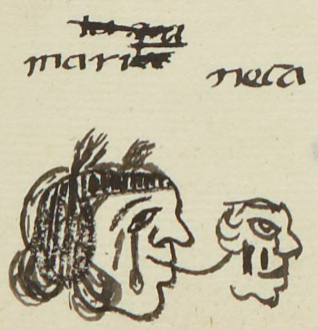Nenca (MH608r)
This black-line drawing of the compound glyph for the personal name Nenca ("Idle" or "Unemployed") is attested here as a woman's name. It shows a human head in profile looking toward the viewer's right. The short hair might suggest that this is a man, but then the cheek has the double vertical lines of the phonetic syllable "hua," which could mean "cihuatl" (woman), in this case.
Stephanie Wood
The context shows that this is a woman's name, and the tears suggest that she is a widow. Nencauh, a seeming variation on the name Nenca, refers to a servant, which could presumably be male or female. A "nencacihuatl" is found in the collection Vidas y Bienes Olvidados edited by Teresa Rojas Rabiela, Elsa Leticia Rea López, and Constantino Medina (1999), 242–243. In that example, it is a woman's name, and it specifies that the nenca was meant to be thought of as a female (at least in that case).
The five extra days in the calendar of 360 days (xiuhpohualli) were called nemontemi (useless days). It was unlucky to be born on these days. A man who was born in this period was called nenoquich and a woman was called nencihuatl. This is explained in the Florentine Codex in Book 2, folio 12 recto (see: https://florentinecodex.getty.edu/book/2/folio/12r). These individuals were considered unlucky, ill-fated, and even useless. A great many individuals in the Matrícula de Huexotzinco have names beginning with the negative syllable Nen-. Perhaps they were born in that ill-fated period, or perhaps the negative syllable came to be even more liberally applied. With men, for instance, Nentequitl (perhaps a lazy worker) was much more common than Nenoquich. When presented visually, the nen- syllable could derive from nenetl (a figure or sculpture of a deity or a doll). Nenetl also had an association with women’s genitals, which has caused much speculation about a negativity associated with women and their sex, but that might have come from European religious influence. In the colonial context, such concepts and perceptions could become muddied.
Stephanie Wood
maria neca
María Nenca
Stephanie Wood
1560
Jeff Haskett-Wood
widow, abandoned one, idle person, sad, sentimientos, triste, viuda, abandonada, mujer ociosa, floja, nombres de mujeres

nenca, to be idle, https://nahuatl.wired-humanities.org/content/nenca
necahual, abandoned one, https://nahuatl.wired-humanities.org/content/necahual
Mujer Ociosa
Stephanie Wood
Matrícula de Huexotzinco, folio 608r, World Digital Library, https://www.loc.gov/resource/gdcwdl.wdl_15282/?sp=298.
This manuscript is hosted by the Library of Congress and the World Digital Library; used here with the Creative Commons, “Attribution-NonCommercial-ShareAlike 3.0 License” (CC-BY-NC-SAq 3.0).









